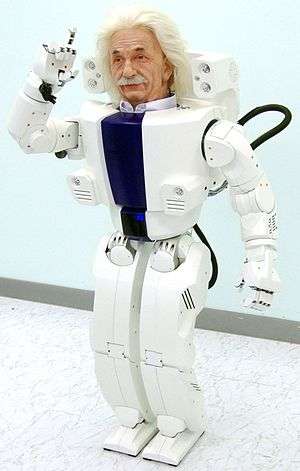David Hanson (robotics designer)

David Franklin Hanson, Jr. is an American robotics designer and researcher, responsible for the creation of a series of realistic humanoid robots.[1]
Early life and education
In the 1980s, Hanson spent two years studying at the University of North Texas in Denton.[2] In 1992, he was accepted into the BFA program at Rhode Island School of Design in Providence.[2] He received his Ph.D. in aesthetic studies and interactive arts and engineering from the University of Texas at Dallas in spring of 2007.
Career
Hanson develops human-like robots with realistic facial expressions and conversational abilities [Hanson et al., 2006]. Hanson currently serves as president and founder of Hanson Robotics.
Hanson previously worked at Walt Disney Imagineering.[3]
Hanson’s robots were shown first at the 2002 AAAI conference in Edmonton, Canada [Hanson, 2002] and in 2003, he showed the Kbot at the American Association for the Advancement of Science (AAAS) annual meeting [Ferber, 2003]. In 2005, Hanson and team received an AAAI award for their "intelligent conversational portrait" of Philip K. Dick [AI Magazine, Fall 2005]. First shown at the 2005 Nextfest, the robot incorporated thousands of pages of the writings of PKD, including journals and letters, into an LSA corpus and conversational system constructeandroid [Hanson et al., 2005]. Hanson's work on the PKD robot is documented in the nonfiction book, How To Build An Android.[4]
In November 2005, Hanson demonstrated an expressive walking humanoid, a portrait of Albert Einstein, in collaboration with the KAIST Hubo group of Korea. KAIST built the walking body, and Hanson built the head using elastic polymer called Frubber [WIRED, 2006].
Hanson has also designed and built a series of Conversational Character Robots. These have heads incorporating Frubber, with varying levels of facial mobility and expressiveness, and are capable of responding to human speech. Projects include Joey Chaos, Jules (created for University of West England in Bristol, UK) and Alice (created for MIRALab in Geneva, Switzerland). He developed BINA48 for Martine Rothblatt's Terasem Movement, which he unveiled in 2010.
He gave a TED talk in February 2009.[5]
Publications
- (with Mathews, E., Olney, A., Zielke, M., Pereira, A.) (2005). Upending the uncanny valley, in AAAI conference proceedings.
- "Expanding the Design Domain of Humanoid Robots", Proc. ICCS CogSci Conference, special session on Android Science, Vancouver, 2006.
- (with Jun-Ho O., Han I. Y., Kim J. K., Kim, W. S., Park, I.W.) "Design of Android type Humanoid Robot Albert HUBO", Proc. IEEE/RJS IROS Robotics Conference, Beijing, 2006.
- "Expanding the Aesthetics Possibilities for Humanlike Robots", Proc. IEEE '''Humanoid Robotics''' Conference, special session on the Uncanny Valley; Tskuba, Japan, December 2005.
- (with Olney A., Prilliman S., Mathews E., Zielke M., Hammons D., Fernandez R., Stephanou H.) "Upending the Uncanny Valley", Proc. AAAI's National Conference, Pittsburgh, 2005.
- (with White V.) "Converging the Capabilities of ElectroActive Polymer Artificial Muscles and the Requirements of Bio-inspired Robotics", Proc. SPIE’s Electroactive Polymer Actuators and Devices Conf., 10TH Smart Structures and Materials Symposium, San Diego, US, 2004.
- (with Rus D., Canvin S., Scmeirer G.) "Applications of Bio-inspired Robotics", Ch.10 of Biologically Inspired Intelligent Robots. Bar-Cohen, Y and Breazeal, C. (Ed.) SPIE Press, May 2003.
- "EAP Actuator Design for Biologically-inspired Face-Based Communication Robots". Proc. SPIE’s Electroactive Polymer Actuators and Devices Conf., 9th Smart Structures and Materials Symposium, San Diego, US, 2003.
- "Bio-inspired Facial Expression Interface for Emotive Robots", Proc. AAAI National Conference in Edmonton, CA, 2002.
References
- ↑ Slagle, Matt (2 February 2004). "Can robots look all too human?". MSNBC. Retrieved 26 August 2010.
- 1 2 "The Man Who Mistook His Girlfriend for a Robot". Popular Science.
- ↑ "Scientists try to make robots more human". USATODAY.com.
- ↑ Dufty, David F., How To Build An Android: The True Story of Philip K. Dick's Robotic Resurrection, Henry Holt and Company, 2012
- ↑ Hanson, David. "David Hanson: Robots that "show emotion" | TED Talk". TED.com.